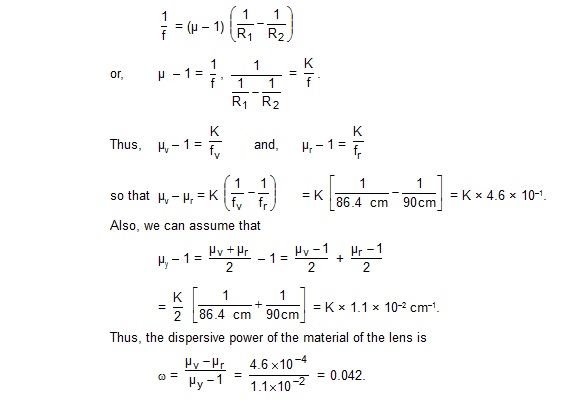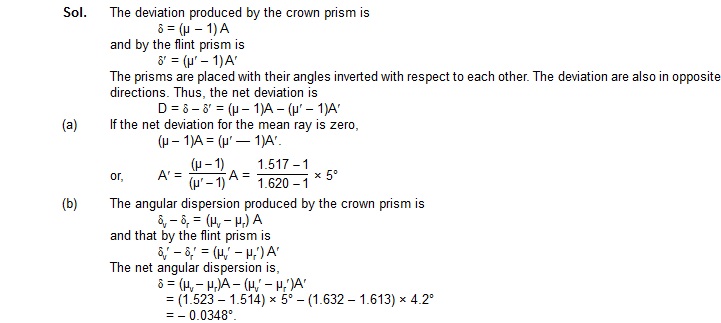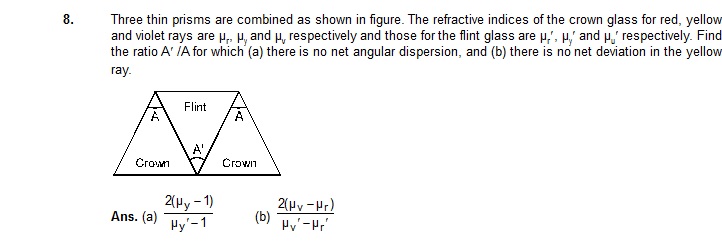Solved Examples
1. Find the dispersive power of flint glass. The refractive indices of flint glass for red, yellow and violet light are 1.613, 1.620 and 1.632 respectively.

2. The focal length of a thin lens for red and violet light are 90.0 cm and 86.0 cm respectively. Find the dispersive power of the material of the lens. Make appropriate assumptions.
Sol. We have

Questions for Short answer
![]()
large refracting angle? it is also valid for a glass slab or a glass sphere ?

3. If three identical prisms are combined, it is possible to pass a beam the emerges undeviated? Undispersed?
4. “Monochromatic light should be used to produced pure spectrum”. Comment on this statement.
5. Does focal length of a lens depend on the colour of the light used? Does focal length of a mirror depend on the colour?
6. Suggest a method to produce a rainbow in your house.
Objective - I
1. The angular dispersion produced by a prism
(A) increases if the average refractive index increases
(B) increases if the average refractive index decreases
(C) remains constant whether the average refractive index increases or decreases
(D) has no relation with average refractive index
2. If a glass prism is dipped in water, its dispersion power
(A) increases
(B) decreases
(C) does not change
(D) may increase or decreases depending on whether the angle of the prism is less than or greater than 60°

4. Consider the following two statements :
(i) line spectra contain information about atoms
(ii) bond spectra contain information about molecules
(A) both i and ii are wrong (B) i is correct but ii is wrong
(C) ii is correct but i is wrong (D*) both i and ii are correct
5. The focal length of a converging lens are fv and fr for violet and red light respectively.
(A) fv > fr (B) fv – fr (C*) fv < fr
(D) any of the three is possible depending on the value of the average refractive index µ
Objective - II
1. A narrow beam of white light goes through a slab having parallel faces.
(A) the light never splits in different colours
(B) the emergent beam is white
(C) the light inside the slab is split into different colours
(D) the light inside the slab is white
2. By properly combining two prisms made of different materials, it is possible to
(A) have dispersion without average dispersion
(B) have deviation without dispersion
(C) have both dispersion and average deviation
(D) have neither dispersion nor average deviation
3. In producing a pure spectrum, the incident light is passed through a narrow slit placed in the focal plane of an achromatic lens because a narrow slit
(A) produces less diffraction
(B) increases intensity
(C) allows only one colour at a time
(D) allows a more parallel beam when it passes through the lens
4. Which of the following quantities related to a lens depend on the wavelength of wavelengths of the incident light?
(A) power (B) focal length
(C) chromatic aberration (D) radii of curvature
5. Which of the following quantities increase when wavelength is increased? Consider only the magnitudes.
(A) the power of a converging lens (B) the focal length
(C) the power of a diverging lens (D) the focal length of a diverging lens.
Worked Out Examples
1. The refractive indices of flint glass for red and violet light are 1.613 and 1.632 respectively. Find the angular dispersion produced by a thin prism of flint glass having refracting angle 5°.

2. A crown glass prism of angle 5° is to be combined with a flint glass prism in such a way that the mean ray passes undeviated. Find (a) the angle of the flint glass prism needed and (b) the angular dispersion produced by the combination when white light goes through it.
Refractive indices for red, yellow and violet light are 1.514, 1.517 and 1.523 respectively for crown glass and 1.613, 1.620 and 1.632 for flint glass.

The angular dispersion has magnitude 0.0348.
3. The dispersive powers of crown and flint glasses are 0.03 and 0.05 respectively. The refractive indices for yellow light for these glasses are 1.517 and 1.621 respectively. It is desired to form an achromatic combination of prism of crown and flint glasses which can produce a deviation of 1° in the yellow ray. Find the refracting angles of the two prism needed.
Sol. Suppose, the angle of the crown prism needed is A and that of the flint prism is A¢. We have


Exercise
1. A flint glass prism and a crown glass prism are to be combined in such a way that the deviation of the mean ray is zero.
The refractive index of flint and crown glasses for the mean ray are 1.620 and 1.518 respectively. If the refracting angle
of the flint prism is 6.0°, what would be the refracting angle of crown prism?
Ans. 7.2°
2. A certain material has refractive indices 1.56, 1.60 and 1.68 for red, yellow and violet light respectively.
(a) Calculate the dispersive power.
(b) Find the angular dispersion produced by a thin prism of angle 6° made of this material.
Ans. (a) 0.2° (b) 0.72°
3. The focal lengths of a convex lens for red, yellow and violet rays are 100 cm, 98 cm and 96 cm respectively.
Find the dispersive power of the material of the lens.
Ans. 0.041
4. The refractive index of a material changes by 0.014 as the colour of the light changes from red to violet.
A rectangular slab of height 2.00 cm made of this material is placed on a newspaper. when viewed normally
in yellow light, the letters appear 1.32 cm below the top surface of the slab. Calculate the dispersive power
of the material.
Ans. 0.026
5. A thin prism is made of a material having refractive indices 1.61 and 1.65 for red and violet light. The dispersive power of the material is 0.07.
It is found that a beam of yellow light passing though the prism suffers a minimum deviation of 4.0° in favourable conditions. Calculate the angle of the prism.
Ans. 7°
6. The minimum deviation suffered by red, yellow and violet beams passing through an equilateral transparent prism are 38.4°, 38.7°
and 39.2° respectively. Calculate the dispersive power of the medium.
Ans. 0.0206
7. Two prisms of identical geometrical shape are combined with their refracting angles oppositely shape are combined with their refracting
angles oppositely directed. The materials of the prisms have refractive indices 1.52 and 1.62 for violet light. A violet ray is deviated by 1.0°
when passes symmetrically through this combination. What is the angle of the prism?
Ans. 10°


Ans. (a) 5° (b) 0.03° (c) 6° (d) 0.45°
11. The refractive index of a material M1 changes by 0.014 and that of another material M2 changes by 0.024 as
the colour of the light is changed from red to violet. Two thin prisms one made of
M1(A = 5.3°) and other made of M2(A = 3.7°) are combined with their refracting angles oppositely directed.
(a) Find the angular dispersion produced by the combination.
(b) The prism are now combined with their refracting angles similarly directed. Find the angular dispersion produced by the combination.
Ans. (a) 0.0146° (b) 0.163°